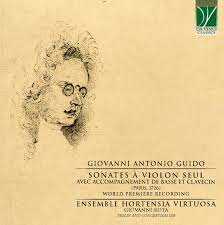Anfang des 18. Jahrhunderts stellte Philippe II. d’Orléans (Regent in Frankreich als Louis XV noch minderjährig war), ein ‘Italienisches Ensemble’ zusammen, dem auch französische Musiker angehörten. Mit diesem Ensemble gab Giovanni Antonio Guido (1675?-1728?) sein Debüt in Frankreich. Innerhalb von zwei Jahren stand er im Zentrum der Musikwelt von Paris. Vor dem Hintergrund tiefgreifender sozialer und politischer Entwicklungen wurde intensiv über den ästhetischen Wert italienischer und französischer Musiktraditionen debattiert; dabei wurde die italienische Musik als klangliche Repräsentation einer neuen Gesellschaft gesehen. Guido kam wahrscheinlich als erster neapolitanischer Musiker 1702 nach Paris, wo er als Interpret und Komponist hohes Ansehen erlangte. Er wurde schnell zu einem Protagonisten der tiefgreifenden Veränderungen, die die Kunst und die Entwicklung der Musikästhetik und -kritik beeinflussten. Als Förderer wurde Philippe II. d‘Orléans für Guido bedeutsam.
Guidos Sammlung, erstmals eingespielt, markiert den Wandel zur Assimilierung des französischen und italienischen Stils in den sogenannten Goûts réunis. Ohne die italienische Charakteristik seines Schaffens ganz aufzugeben, führt Guido Züge des französischen Stils ein. Die Geige spielt eigenwillige melodische Linien, während der Bass mit einfacheren Harmonien begleitet und nur selten in einen Dialog mit der Violine tritt. Die Virtuosität dieser Sammlung zeigt ein anderes Vorbild, nämlich Antonio Vivaldi.
Giovanni Rota als Solist im Ensemble Hortensia Virtuosa stellt diese Werke mit eloquent ausdrucksstarkem Spiel vor. Damit schafft er es mühelos, sowohl die italienische Spielfreude als auch die französische Eleganz zu einem einheitlichen Klangerlebnis zu gestalten. Das Ensemble mit Cello, Theorbe bzw. Gitarre und Cembalo gibt mit gestalterischer Kraft die Basis für die Solostimme, über der sie brillieren kann.
At the beginning of the 18th century, Philippe II d’Orléans (regent in France when Louis XV was still a minor), put together an ‘Italian Ensemble’ that included French musicians. It was with this ensemble that Giovanni Antonio Guido (1675?-1728?) made his debut in France. Within two years he was at the center of the musical world of Paris. Against the backdrop of profound social and political developments, there was intense debate about the aesthetic value of Italian and French musical traditions; Italian music was seen as representative of a new society. Guido was probably the first Neapolitan musician to arrive in Paris in 1702, where he became highly regarded as a performer and composer. He quickly became a protagonist of the profound changes that influenced art and the development of musical aesthetics and criticism. As a patron, Philippe II d’Orléans became significant for Guido.
Guido’s collection, recorded for the first time, marks the shift toward the assimilation of French and Italian styles in the so-called Goûts réunis. Without completely abandoning the Italian characteristics of his work, Guido introduces traits of the French style. The violin plays idiosyncratic melodic lines, while the bass accompanies with simpler harmonies and rarely enters into a dialogue with the violin. The virtuosity of this collection shows another model, Antonio Vivaldi.
Giovanni Rota, as soloist in the Ensemble Hortensia Virtuosa, presents these works with eloquently expressive playing. He thus effortlessly manages to shape both the Italian temperament and the French elegance into a unified sound experience. The ensemble with cello, theorbo or guitar and harpsichord provides the inspired basis for the solo instrument.




















